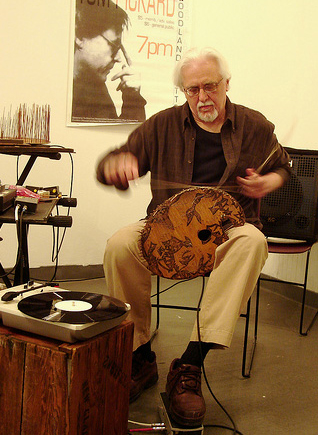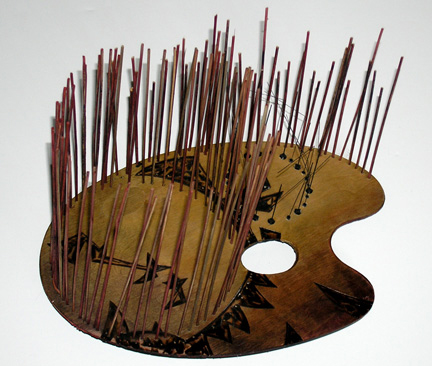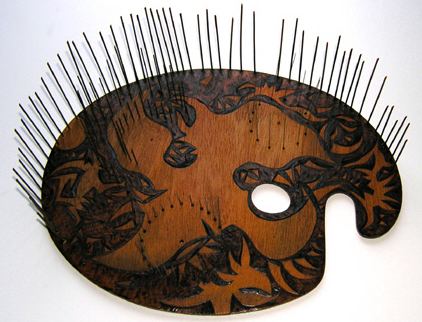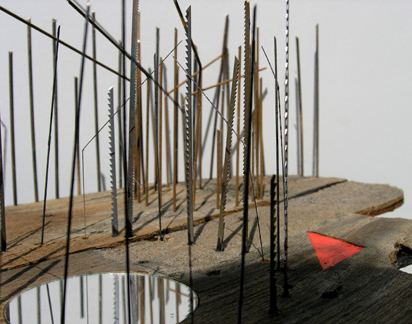
John Kannenberg - Hal Rammel, LOST DATA Project, 2008, Woodland Pattern Book Center, Milwaukee
The Amplified Palette
The Milwaukee-based music artist, instrument builder, visual artist, and writer, Hal Rammel, has for four decades pursued a diverse range of fruitful projects and collaborations, becoming a focal point of experimental music. Besides solo performances, Rammel and his homemade instruments, most of all, the amplified palette, are best heard in his duo with Steve Nelson-Raney, and the trios Raccoons (with Jon Mueller and Chris Rosenau) and Audiotrope (with Nelson-Raney and Thomas Gaudynski). These ensembles, part of Rammel's work with other musicians in Milwaukee, Chicago, and elsewhere, place him among a small number of Americans who concoct music closer to the European preference for completely-improvised works and "extended" techniques as compared to the earlier tradition of Free Jazz. But Rammel, like John Zorn or Scott Fields, also ranks among a small, but influential, group of artists who came of age at the height of the A. A. C. M.'s influence, and who built upon the models they and others [notably, Ornette Coleman] provided, specifically in questioning the divide between composed and improvised music, exploring the possibilities of electronic and other new instruments as well as multi-instrument-alism, and purposefully resorting to self-publishing and -promotion. While Rammel's contributions to these pursuits is brought to light by the essay below, we should note too that he is the proprietor and curator of his own label, Penumbra Music, which has featured Improvised music in addition to records more radical and diverse in methodology. He is also the host of a radio program on WMSE (91.7 F M, Milwaukee) called Alternating Currents, and the organizer of music performances by his peers, held in Milwaukee at the Woodland Pattern Book Center. Moreover, his homemade-instrument-alism reflects his interests beyond music, encompassing comics, photography, and the Dada and Surrealist movements among other things. Some of these interests helped lead to his excellent book, Nowhere in America: The Big Rock Candy Mountain and Other Comic Utopias [1990], a study of folklore stretching from antiquity into the Twentieth Century that will surely challenge any reader's conception of surrealism, popular culture, and Utopianism, not least in illuminating the evocative connections among them. Rammel previously published an article about his homemade instruments in Rubberneck magazine in 1996. Also, visit his site for information on his recordings.
--
My parents were both artists: my mother painted when I was young, and did ceramic and metal sculpture later in her life; my father was a photographer and wood craftsman, as well as a photo-journalist by profession. So I grew up in a house where making things and exploring new ideas were everyday activities. I decided in my teens that I wanted to pursue a similar course, and started drawing and making collages. This was all of a piece with reading, listening to Jazz, watching movies, and so on. I had been exposed to modern art throughout my childhood, so the historical continuity, the groundwork, was firmly at hand. Abstract and surrealist painting and imagery fascinated me, so in my reading I doggedly pursued the art, poetry, and theater of the early Twentieth Century. I knew there were new directions to take those ideas in new times—this was the early 1960's—and I still feel that way.
I had no formal musical training as a child, though my mother was a serious opera and symphony fan. My father sang all the time: show tunes, cowboy songs, novelty songs, everything. When I started listening to Jazz, and its recasting of the standard songbook—listening to Sonny Rollins, Art Tatum, and so on—I already knew the tunes. In my late teens and early twenties, I occasionally would try to pick up an instrument, but doing so never brought any sense of accomplishment. Socially, playing some sort of improvised music with friends was often part of hanging out together; skill was not an issue.
Douglas Ewart served as a great inspiration at this point in my life. He was the only other instrument builder I knew. I saw and heard him at events organized by the Association for the Advancement of Creative Musicians (A. A. C. M.). He even used one of the mbira I gave him, at a concert with Henry Threadgill and Joseph Jarman. I built my first string instrument—sort of a three-sided free-standing ukulele—thinking he could use it alongside the amplified instruments he and George Lewis had begun to explore in bands like Quadrisect in the late 1970's. I'm not sure if he ever used it. It looked intriguing but wasn't very resonant.
My years of attending A. A. C. M. concerts from 1966 onward were the essence of my musical education. Observing musicians interact, experiment with diverse instrumental forms, explore the theatrical side of music, intertwine new ideas about composition and improvisation, self-produce concerts and recordings, and overall take such an exceptionally-inclusive approach toward what music could be and what it could represent—socially, culturally, and politically—was a revelation. Certainly I was also reading in depth about the likes of Harry Partch, John Cage, and Sun Ra, but here it was all playing out in front of my own eyes in real life. It was a remarkable time to live in Chicago. I was a retiring guy, didn't know any musicians besides Ewart, hardly spoke to anyone at these concerts, but I was still part of the audience at every opportunity.
In the mid-1960's, the only music that dealt with the realities of life as I saw and experienced it was what was then called the "new wave of Jazz" or "Free Jazz." I knew of and heard some of what was coming out of New York art-music circles (Fluxus and so on) but it didn't impress me much. It seemed too concerned with itself and its little world. John Coltrane, Albert Ayler, Ornette Coleman, Paul and Carla Bley, Sun Ra.... That was life in the wider world, embodying all of its marvels and travails.
Moving beyond the mbira, as I pursued other possibilities for building instruments from scrap wood and metal, the idea that I could improvise with something I had built, facilitated by my own physical capabilities, took hold. This notion in turn inspired new ideas and developments. The early instruments, including the snath and the devil's fiddle, were all acoustic, and much of my improvising with them extended out of my exploration of the musical saw. This is what I had to bring to the table when I began playing out in the early 1980's with Davey Williams and LaDonna Smith, with Russell Thorne, and a little later with Gene Coleman's various projects whose participants included Jim O'Rourke, Kent Kessler, Michael Zerang, John Corbett, and other Chicagoans. Zerang deserves special mention, as he was one of the few improvising musicians in Chicago at the time curating an Improvised-music series (at Links Hall and the bar downstairs called Lower Links). The trio Liof Munimula featured Michael, guitarist/violinist Dan Scanlan, and instrument inventor Don Meckley, who was an inspiring presence for someone like myself, watching and listening for new approaches to improvising with often-stubborn musical objects.
Also in the early 1980's, I met Lou and Dawn Mallozzi, who had helped found the Experimental Sound Studio in Chicago. They asked me to present workshops there on instrument invention and design; in turn, I received similar opportunities in the Sound department of the School of the Art Institute of Chicago. Lou and I went on to collaborate on the studiophonic collection Whole or By the Slice, and perform under that name as both a duo and a trio with Terri Kapsalis.
The triolin became a crucial part of my little arsenal of homemade acoustic instruments. It originated from building a nail violin, and then diverting that concept: having a triangular, instead of circular, resonator, and switching from nails to longer metal rods fitted loosely in the soundboard so that some were very resonant, some were muted, and others didn't do much more than rattle against one another. Holding the instrument with one hand to rotate it against a bow held in the other allowed for a comfortable playing style for me. Other triolin ideas expanded, setting the stage for an electro-acoustic version, the amplified palette.

Hal Rammel - palette, wood with bamboo rods and circle of metal wires
This new invention took the form, obviously, of a painter's palette, ergonomically designed to be hand-held, light, and overall perfectly fitted for—in this case—a miniature version of table-top electro-acoustics. A contact microphone is fixed to the back in order to amplify sounds that otherwise would be too quiet and too insubstantial for music-making. Amplified, these sounds—produced by thin wooden and metal rods—are rich and full, capable of making expressive music. I'm not interested in exploring many of the conventions of music form, like chords, harmony, melody, and so on. Therefore, I cut the rods in random lengths, juxtapose different lengths and sizes in intense proximity, add elements to the design that make it difficult to play individual pitches or melodic lines; and then attempt to wrestle musicality out of the result.
The palette also serves as a platform for amplifying any object set on its surface. In the context of the electric guitar with its magnetic pick-up, Davey Williams uses the term, "object guitar," and, in generous acknowledgement of Davey's genius, I play "object palette."
I originally intended for the palette's amplified signal to be processed in a fashion that I admired in Russell Thorne's live electronics with cello and that I had listened to on records by Phil Wachsmann. The palette was still a solo instrument at this time; in group improvisations I stayed acoustic, playing saw, triolin, gopychand and other single-string instruments I had built. Since the palette is not a tuned instrument in any sense of the word (it plays distinct pitches, but I make no effort to tune it beyond making sure that it isn't in tune) playing with others was already a challenge. There are no scales, no conventional chords, etc., that insure the basis of a shared musical dialogue.
In the early solo performances with the palette, I used several sample/delay devices in tandem with a little unit for reverb, flange, and other effects. As this set-up expanded, I could manipulate six different loops in real time, modulating the pitch and tempo of each, fading them in and out—without pre-recorded samples. This combination of live processing and looping was used for Elsewheres, the first release on Penumbra Music. Every track was recorded directly to tape, with no over-dubbing.
A great discovery for me has been the sound of bowed wood. Few musical instruments explored the possibilities offered by wood. Hans Reichel's daxophone is one, and he has spent years working with it to fantastic result. Bowing wood, and in turn having the means to build and manipulate the sound produced, was for me an extension of Max Ernst's frottage process, wherein pencil rubbing over paper placed atop wood-grain textures lead to the unforeseen, or "automatic," development of an image or set of figures. I was well-acquainted with that process visually and found it easy to apply it musically in live performances and in the studio.
I also developed compositions based on the "object palette" idea mentioned above. I recall a piece I did at the Lunar Cabaret that used the palette itself as a tiny stage on which various objects interacted—an alarm clock, bells, a pair of scissors, altered music boxes, a flashlight, etc. I didn't play the palette as such but used it as the setting for a little theatrical encounter.

Hal Rammel - palette, wood and metal, built for the exhibition, The Shapes of Sound: Musical Instrument Invention in the Midwest, Woodland Pattern Book Center, Milwaukee
After a time, I got tired of the processing and effects. They always sound like effects. I also wanted to use the palette in duo or larger groupings, where I had to be able to move quickly, to be more fluid, less encumbered by the slower progression of electronic processing. So I expanded my playing techniques. I designed different mallets and bows and other playing devices, and incorporated percussive elements (the small inner circles of metal rods that overlap and buzz against each other). My playing position shifted from standing and holding the instrument in one hand to sitting with the palette between my knees so that I could use both hands, use two bows at the same time, or manipulate the rods as I struck them. These changes opened up new possibilities in using a single instrument throughout the course of an improvisation. As these were added, I fashioned new versions of the palette to complicate my playing techniques and force new discoveries as I tried to figure out, "now how do play this?"
These variations on the palette—created by changing the overall shape of the board, or by adding or subtracting sounding elements—each have their own musical character. With the accumulation of resonant frequencies from the various wood and metal rods fixed to it, even with the addition of small springs to the underside, an individual palette has its own unique resonance, becomes its own room, so to speak, without the addition of any effects or signal processing. Amplification via contact microphones makes the slightest change in attack a dramatic change in sound. From the softer cork mallets to mallets made from metal washers, plastic discs, or pieces of cloth, from bows made from guitar strings or wooden dowels, and so on, exploration of technique became of a piece with instrument invention. No two palettes will sound alike; even if I tried to build two similar instruments, they would each provoke new ideas about how to play. On top of all this, placing various elements in difficult playing positions forces me to reconsider how to play the palette. The sum-total of these provocations keeps the instrument alive for me.

Hal Rammel - palette, wood from demolished shed and metal rods (including coping saw blades) with glass mirror afixed
There is nothing like playing with other people, to be swimming in a river that will sweep you away if you don't have the means to stay on course—to effect changes, adaptations, and sudden discoveries in the heat of musical circumstance. I've been very fortunate to work with musicians who were willing to engage in a musical conversation with the palette. Very early on, Russell Thorne was enthusiastic without hesitation, so I never gave the decision to play with others a second thought. In Milwaukee, cellist Matt Turner, guitarist Thomas Gaudynski, and saxophonist Steve Nelson-Raney have played with me extensively, finding ways to engage in this conversation using conventionally-constructed sound sources.
The first recordings of the palette appeared on the cassette Music from the Jaws of Sound [Cloud Eight]. After Elsewheres, the only recorded documents of solo work from the past ten years are the set of 7-inch singles called Lost Data and the Crouton 10-inch Like Water Tightly Wound. Audiotrope, a current trio with Nelson-Raney and Gaudynski, shows up on several trio discs like Feedback for the Nation [Utech Records, 2005] and Audiotropism [Necessary Arts, 2005]. However, a new solo palette record is in the works, and will appear in early 2009 as a Penumbra release. [Midwest Disquiet was released by Penumbra Music in 2010—ed.]
